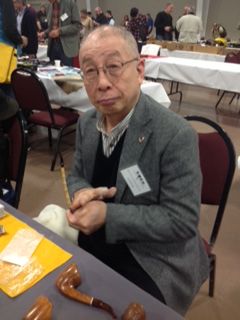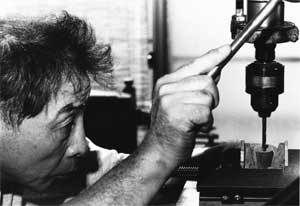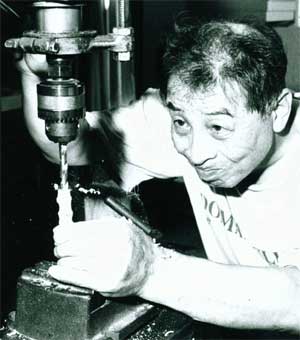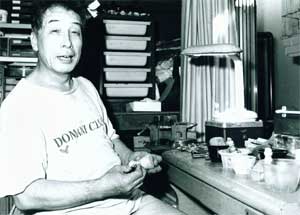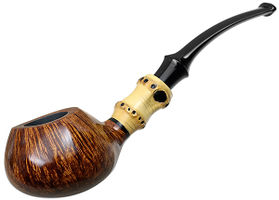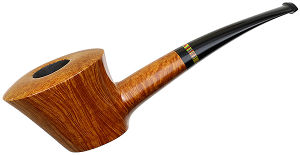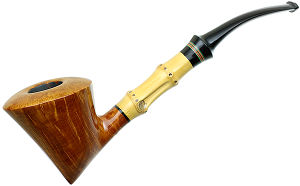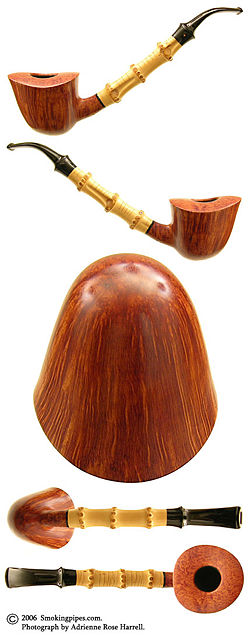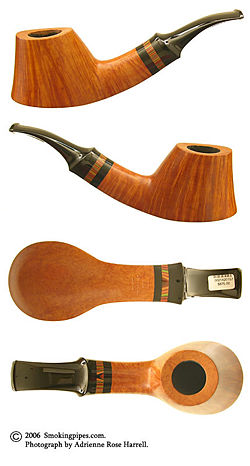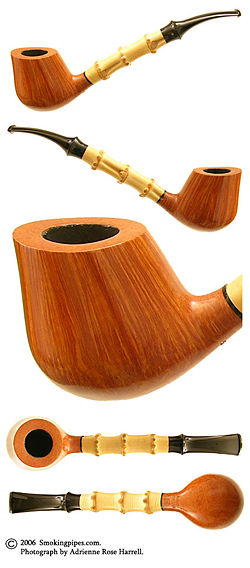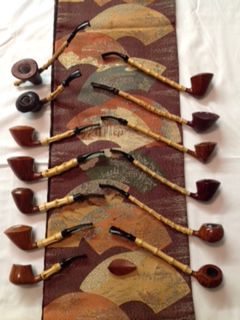Satou
Please feel free to contribute at the end of this article, but please do not edit within the existing article, which is courtesy of smokingpipes.com. All rights reserved: see Pipedia:Copyright
The tradition of Japanese craftsmanship is famed throughout the world. From the creation of exquisite pottery to the forging of fine swords,workmanship and artisanship has been a significant cornerstone of Japaneseculture. This tradition has carried over considerably well to pipe making. For Tsuge, certainly the most famous of the Japanese pipe making firms, this involved an evolution from a firm focused on the carving of ivory relatingto the traditions and rituals of Buddhism to the making of pipes as ivory became increasingly scarce.
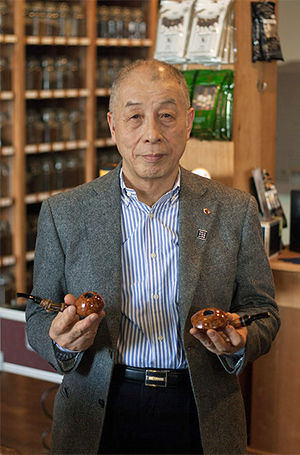
Indeed, Tsuge was Satou's first pipe making home. Smio Satou worked for Tsuge for twenty-five years. However, the story begins even earlier, with Satou's father. His father was one of the first pipe artisans in Japan, during the late 1940s and 1950. Actually, it would be more accurate to say that he was one of the first pipe artisans in briar that was focused on European style pipes. Kiseru, traditional Japanese pipes, were a standard in Japanese life prior to the 20th century. Though pipe smoking in Kiseru was common before the late 1940s and many Japanese also smoked western style pipes, until that time there were no briar pipe makers in Japan. Smio Satou's father was one of the first pipe makers for Fukashiro, the first briar pipe maker in Japan. On an interesting historical side note, according to Satou, his father repaired pipes for Douglas Macarthur following the war. Later in his father's career, he subcontracted pipe making and repair work for Tsuge.
Satou currently makes less than forty pipes a year and his pipe making has become more a hobby than a profession now that he is retired. He generally spends two to three days making a pipe, focusing particularly on the finish and the mechanics of each piece.
It is perhaps Satou's finishing work and mechanics that truly set him apart from other pipe makers. Mechanically, his pipes are flawless and his pipe engineering is among the finest, if not the finest, in the world. Pages could be filled describing every technique Satou uses to ensure perfect mechanics, finish and durability in his pipes, but a couple of examples should illustrate the point:
Satou frequently uses long thin pieces of bamboo on his pipes. Though many makers from all over the world use bamboo, it could be argues than none have the facility with the material that Satou has. By using metal tenons and sheathing the inside of the bamboo in nylon, Satou is able to use far thinner pieces than most pipe makers would consider using. Not only are the pieces thinner, but the sheathing process also allows bamboo shank extensions to be far stronger and far longer than those found on most any other pipes. In addition to this, Satou does not settle for gluing his tenon into the stem (provided they are not from the same piece). Rather, he fixes the tenon in place with a metal pin that extends from the surface of the stem, down into the tenon.
Satou is also known for his unusual finishing techniques. Most high quality pipe makers use carnuba wax, the resin from a particular kind of South American nut. carnuba has significant advantages: it protects the pipe, gives it a lustrous finish and is breathable. Of course, it is the last advantage that makes it better than a varnish or plastic based lacquer that is often found on less expensive pipes. Satou does something completely different. For centuries, Japan has been home to some of the finest high-quality furniture in the world. Much of this furniture receives a special wood resin as its final coating after staining. Satou experimented with this special coating and discovered that it allowed heat and gas exchange as well (or better) than carnuba, but is a far more durable finish than the wax. According to Satou, the pipe will never need to be waxed. Additionally, the pipe achieves a more lustrous patina than does a pipe coated with carnuba. I can personally attest to the fact that the coating does exactly what Satou claims it does: the smoking is not effected, the finish is better maintained over time and it doesn't need to be rewaxed. As to the exact compound he uses, well, he is not overly willing to share that information.
Satou's styling, to a greater degree than even Tokutomi or Tsuge, is uniquely Japanese. He seems to have been less influenced by the Danish makers. Though the fusion of Danish into Japanese aesthetic has been hugely successful for both of those makers, it certainly is of interest that Satou has maintained a very traditionally Japanese aesthetic. Perhaps Satou's marquee style is the very long bamboo shank extension with a fairly small bowl. In many ways, this style is more reminiscent of kiseru pipes than it is of Western briar pipes. When he isn't using bamboo, he often uses water buffalo horn as a ferrule and occasionally uses standard gold or silver bands on the shank. Another recognizable feature of some of Satou's pipes without bamboo is an incredibly deep bend in the shank- one that would be impossible to achieve with a standard drill bit. When asked how he did it, he smiled, shook his head and said it was a secret.
Gifted, quiet, humble and eminently Japanese, Smio Satou is doubtlessly one of the world's great pipe makers.
- Beautiful examples, courtesy Smokingpipes.com
"If there is a pipe artisan in the world that does better work in bamboo than Smio Satou, I am not aware of him. If there is a craftsman who imbues his work with better engineering and a more meticulous attention to detail, I have yet to see his work. The shape of this pipe is a bit of departure for the normally conservative Satou-san, with a subtly asymmetrical undulating rim and a positively organic juxtaposition of shank and bowl. The straight grain on the bowl is stellar and the birdseye of the rim is about as close to perfect as you are likely to see on this side of the veil." --Bear Graves, courtesy of Smokingpipes.com.
"Small, quiet, harmonious, this volcano presents much of what is best in a pipe from Satou-san. The rim bears the most subtle of oval shapes, as well as an ever-so-slight saddle contour. Satou-san then juxtaposes a back of bowl, with about 80 degrees of angle to the shank, with a gently concave front. This balancing of surfaces serves to visually augment the prow at the front of the heel. The shank and bit are quite thick, and compositionally perfect. The tsuishu inlay in the bit is incredibly labor intensive and just the right ending to this marvelous composition." --Bear Graves, courtesy of Smokingpipes.com.
"Satou Smooth Brandy with Bamboo: I am very taken with this particular pipe from Smio Satou. The subtle curvature of the bamboo and the slight forward lean of the bowl create a stunning visual combination. Not only does the bamboo exhibit that beautiful curve and thereby contribute so much to the larger composition, it's an incredibly beautiful piece of bamboo in its own right, possessing clean, regularly spaced, well-defined knuckles. The grain on the bowl is nothing short of extraordinary-- tight, super-fine, regular and contrasted beautifully. There are a couple of minor sand-pits near the bottom of the bowl, however. All in all, an extraordinary piece." -- Sykes Wilford, courtesy of Smokingpipes.com.
*You might also enjoy listening to Brian Levine's excellent interview of Satou on the PipesMagazine Radio Show.
